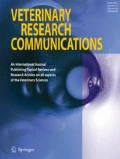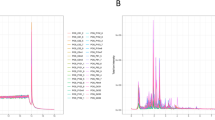Abstract
Cows' urine was analysed by gas chromatography–mass spectrometry (GC-MS). The profiles from preovulatory, ovulatory and postovulatory samples were compared to establish any qualitative and quantitative differences that might have potential value in olfactory communication. Dichloromethane was used as the solvent for extraction of the compounds. Seven different compounds were detected, of which only two were common to all the chromatograms. The chemical profile of oestrous urine was distinguished by the presence of two specific compounds, viz. di-n-propyl phthalate and 1-iodoundecane, that were not found in the other samples. As oestrous urine has been shown to elicit sexual behaviour in cattle, these two characteristic peaks may represent important chemical compounds that elicit signals that allow the bull to detect `oestrous odours'.
Similar content being viewed by others
REFERENCES
Albone, E.S., 1984. Mammalian Semiochemistry, (Wiley, Chichester), 226-234
Albone, E.S., Blazquez, N.B., French, J., Long, S.E. and Perry, G.C., 1986. Mammalian semiochemistry issues and futures with some examples from a study of chemical signalling in cattle. In: D. Duvall, D. Muller-Schwarze and R.M. Silverstein (eds), Chemical Signals in Vertebrates, 4, (Plenum Press, New York), 27-36
Andreolini, F., Jemiolo, B. and Novotny, M., 1987. Dynamics of excretion of urinary chemosignals in the house mouse Mus musculus during the natural estrous cycle. Experientia, 43, 998-1002
Aron, C., 1979. Mechanisms of control of the reproductive function by olfactory stimuli in female mammals. Physiological Reviews, 59, 229-284
Balakrishnan, M. and Alexandar, K.M., 1985. Sources of body odour and olfactory communication in some Indian mammals. Indian Review of Life Science, 5, 277-313
Boyer, M.L., Jemiolo, B., Andreolini, F., Wiester, D. and Novotny, M., 1988. Urinary volatile profiles of the pine vole Microtus pinetorum and their endocrine dependency. Journal of Chemical Ecology, 15, 649-661
Bramachary, R.L., Poddar-Sarkar, M. and Dutta, J., 1992. Chemical signals in the tiger. In: R.L. Doty and D. Muller-Schwarze (eds), Chemical Signals in Vertebrates VI, (Plenum Press, New York), 471-475
Bronson, F.H., 1971. Rodent pheromones. Biology of Reproduction, 4, 344-357
Bronson, F.H., 1974. Pheromonal influences on reproductive activity in rodents. In: M.C. Birch (ed.), Pheromones, (North Holland, Amsterdam; American Elsevier, New York), 344-365
Crowell-Davis, S. and Houpt, K.A., 1985. The ontogeny of flehmen in horses. Equine Veterinary Journal, 33, 739-745
Denhard, M. and Claus, R., 1988. Reliability criteria of a bioassay using rats trained to detect estrus-specific odour in cow urine. Theriogenology, 30, 1127-1138
Denhard, M. and Claus, R., 1996. Attempts to purify and characterize the estrus-signalling pheromone from cow urine. Theriogenology, 46, 13-22
Denhard, M., Claus, R., Pfeiffer, S. and Schopper, D., 1991. Variation in estrus-related odours in the cow and its dependency on the ovary. Theriogenology, 35, 645-652
Dominic, C.J., 1991. Chemical communication in animals. Journal of Scientific Research (Banaras Hindu University), 41, 157-169
Halpin, Z.T., 1986. Individual odours among mammals: origin and functions. Advances in the Study of Behaviour, 16, 39-70
Hawk, H.W., Conley, H.H. and Kiddy, C.A., 1984. Estrus-related odors in milk detected by trained dogs. Journal of Dairy Science, 67, 392-397
Hiradecky, P., 1986. Volatile fatty acids in urine and vaginal secretions of cows during reproductive cycle. Journal of Chemical Ecology, 12, 187-196
Jemiolo, B., Andreolini, F., Wiesler, D. and Novotny, M., 1987. Variation in mouse (Mus musculus) urinary volatiles during different periods of pregnancy and lactation. Journal of Chemical Ecology, 13, 1941-1956
Kannan, S. and Archunan, G., 1999. Identification of volatile compounds from cheek glands of lesser bandicoot rats and assessment of behavioural response for identified compounds. Indian Journal of Experimental Biology, 37, 798-802
Kannan, S., Ramesh Kumar, K. and Archunan, G., 1998. Sex attractants in male preputial gland: chemical identification and their role in reproductive behaviour in rats. Current Science, 74, 689-691
Ma, W. and Klemm, W.R., 1997. Variations of equine urinary volatile compounds during the oestrous cycle. Veterinary Research Communications, 21, 437-446
Novotny, M., Harvey, S., Jemiolo, B. and Alberts, J., 1985. Synthetic pheromones that promote inter-male aggression in mice. Proceedings of the National Academy of Sciences of the USA, 82, 2059-2061
Patterson, R.L.S., 1968. Identification of 3-hydroxy-5-androst-16-ene as the musk odour components of boar submaxillary salivary gland and its relationship to the sex odour taint in pork meat. Journal of the Science of Food and Agriculture, 19, 434-438
Podder-Sarkar, M. and Bramachary, R.L., 1999. Can free fatty acids in the tiger pheromone act as an individual finger print? Current Science, 76, 141-142
Rasmussen, L.E.L. and Lee, T.D., 1991. Purification and initial characterization of preovulatory urinary pheromone from female Asian elephants (Elephas maximus). Association for Chemoreception Sciences, Abstract 8. Chemical Senses, 16, 569
Rasmussen, L.E.L., Anthony, J., Martin, H. and Hess, D.L., 1996. Chemical profiles of male African elephants, Loxodonta africana: physiological and ecological implications. Journal of Mammalogy, 77, 422-439
Raymer, J., Wieler, D., Novotny, M., Asa, C., Seal, U.S. and Mech, L.D., 1984. Volatile constituents of wolf (Canis lupus) urine as related to gender and season. Experientia, 40, 707-709
Sambraus, H.H. and Waring, Z., 1975. Effect of urine from estrous cows on libido in bulls. Zoologie Saugettierkunde, 40, 49-54
Schwende, F.J., Wiesler, D., Novotny, M., Asa, C., Seal, U.S. and Mech, L.D., 1984. Volatile compounds associated with estrus in mouse urine: potential pheromones. Experientia, 40, 213-215
Weidong, M.A., Clement, B.A. and Klemm, W.R., 1996. Volatile compounds of bovine milk as related to the stage of the estrous cycle. Journal of Dairy Science, 80, 3227-3233
Williams, K.I.H., Burstein, S.H. and Layne, D.S., 1966. Dimethyl sulfone: isolation from human urine. Archives of Biochemistry and Biophysics, 113, 251-252
Author information
Authors and Affiliations
Rights and permissions
About this article
Cite this article
Ramesh Kumar, K., Archunan, G., Jeyaraman, R. et al. Chemical Characterization of Bovine Urine with Special Reference to Oestrus. Vet Res Commun 24, 445–454 (2000). https://doi.org/10.1023/A:1006495404407
Issue Date:
DOI: https://doi.org/10.1023/A:1006495404407




